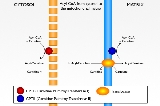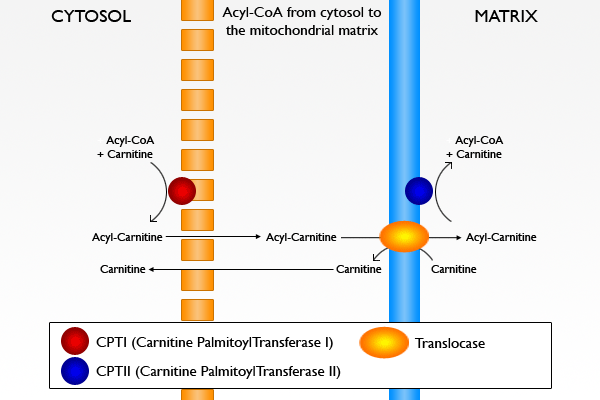
Carnitine-acylcarnitine translocase
Encyclopedia
Carnitine-acylcarnitine translocases are responsible for transporting both carnitine
and carnitine
-fatty acid
complexes into and out of the mitochondria, across the inner mitochondrial membrane.
to cross the external mitochondrial membrane. It then switches the CoA
for carnitine
by the use of the enzyme carnitine palmitoyltransferase I
. The complex then uses facilitated diffusion by Carnitine-acylcarnitine translocase to enter the mitochondrial matrix. Here, the acyl-cartinine complex is disrupted by carnitine palmitoyltransferase II
and the fatty acid rebinds to CoA. Carnitine then diffuses back across the membrane by a second carnitine-acylcarnitine translocase into the inter-mitochondrial membrane space. This is the carnitine shuttle system.
. This disorder prevents the shuttle-like action of carnitine from assisting fatty acids across the mitochondrial membrane and therefore there is decreased fatty acid metabolism. The result of this is an increased number of fat droplets within muscles and liver, decreased tolerance to long term exercise, inability to fast for more than a few hours, muscle weakness and wasting, strong acidic smell on breath (due to protein breakdown)

Carnitine
Carnitine is a quaternary ammonium compound biosynthesized from the amino acids lysine and methionine. In living cells, it is required for the transport of fatty acids from the cytosol into the mitochondria during the breakdown of lipids for the generation of metabolic energy. It is widely...
and carnitine
Carnitine
Carnitine is a quaternary ammonium compound biosynthesized from the amino acids lysine and methionine. In living cells, it is required for the transport of fatty acids from the cytosol into the mitochondria during the breakdown of lipids for the generation of metabolic energy. It is widely...
-fatty acid
Fatty acid
In chemistry, especially biochemistry, a fatty acid is a carboxylic acid with a long unbranched aliphatic tail , which is either saturated or unsaturated. Most naturally occurring fatty acids have a chain of an even number of carbon atoms, from 4 to 28. Fatty acids are usually derived from...
complexes into and out of the mitochondria, across the inner mitochondrial membrane.
Function
This enzyme is required as fatty acids cannot cross the mitochondrial membranes without assistance. The fatty acid is firstly bound to CoACOA
COA can refer to:*Codename Amscray*Cash on Arrival*Cause of action*CedarOpenAccounts*Center of Attention*Certificate of Appealability*Certificate of Approval for marriage or civil partnership in the United Kingdom*Certificate of Authenticity...
to cross the external mitochondrial membrane. It then switches the CoA
COA
COA can refer to:*Codename Amscray*Cash on Arrival*Cause of action*CedarOpenAccounts*Center of Attention*Certificate of Appealability*Certificate of Approval for marriage or civil partnership in the United Kingdom*Certificate of Authenticity...
for carnitine
Carnitine
Carnitine is a quaternary ammonium compound biosynthesized from the amino acids lysine and methionine. In living cells, it is required for the transport of fatty acids from the cytosol into the mitochondria during the breakdown of lipids for the generation of metabolic energy. It is widely...
by the use of the enzyme carnitine palmitoyltransferase I
Carnitine palmitoyltransferase I
Carnitine palmitoyltransferase I also known as carnitine acyltransferase I or CAT1 is a mitochondrial enzyme. It is part of a family of enzymes called carnitine acyltransferases. Three isoforms of CPT1 are currently known: CPT1A, CPT1B, and CPT1C...
. The complex then uses facilitated diffusion by Carnitine-acylcarnitine translocase to enter the mitochondrial matrix. Here, the acyl-cartinine complex is disrupted by carnitine palmitoyltransferase II
Carnitine palmitoyltransferase II
Carnitine O-palmitoyltransferase 2, mitochondrial is an enzyme that in humans is encoded by the CPT2 gene.-Further reading:...
and the fatty acid rebinds to CoA. Carnitine then diffuses back across the membrane by a second carnitine-acylcarnitine translocase into the inter-mitochondrial membrane space. This is the carnitine shuttle system.
Clinical significance
A disorder is associated with carnitine-acylcarnitine translocase deficiencyCarnitine-acylcarnitine translocase deficiency
Carnitine-acylcarnitine translocase deficiency is a rare, autosomal recessive metabolic disorder that prevents the body from converting long-chain fatty acids into energy, particularly during periods without food. Carnitine, a natural substance acquired mostly through the diet, is used by cells to...
. This disorder prevents the shuttle-like action of carnitine from assisting fatty acids across the mitochondrial membrane and therefore there is decreased fatty acid metabolism. The result of this is an increased number of fat droplets within muscles and liver, decreased tolerance to long term exercise, inability to fast for more than a few hours, muscle weakness and wasting, strong acidic smell on breath (due to protein breakdown)


